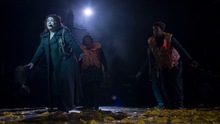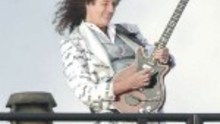All of the pieces mentioned in this article can be found in this spotify playlist, for easier navigation, or, if you prefer something more comprehensive, then have a look at this fantastic playlist which contains the complete works of this month's composer.
Welcome to the world of classical music, where Beethoven is not a dog, Biber is not a teenage heartthrob, Alkan is not a DJ, Sibelius is not a piece of software, Humperdinck is not a sixties crooner, and fingering is not a dirty word. Classical music is everywhere - we get married to Wagner, sleep with Brahms, and die with Chopin, but few of us realise it. Classical music has never been easier to obtain, but remains an intimidating prospect for many people. The need for a little guidance, a small prod in the direction of the masterworks, has never been more essential - and hopefully, that’s what I can provide, by introducing one composer and their key works each month. I don’t want to ramble on too much this time about why you should listen to classical music, because frankly, I’ve done enough of that already.
This month, we’re going way back, deeper into the past than we’ve ever been before, all the way back to Nineteen, sorry, Sixteen Eighty Five! Great Scott! Counterpoint Circuits on, Fugue Capacitor ... Fugueing! Johann, Johann, it’s Maria ... your cousin, Maria Bach! You know that new sound you’re looking for? Well listen to this! That’s right, we’re going Bach to the Future. Insert pun-related groan here.
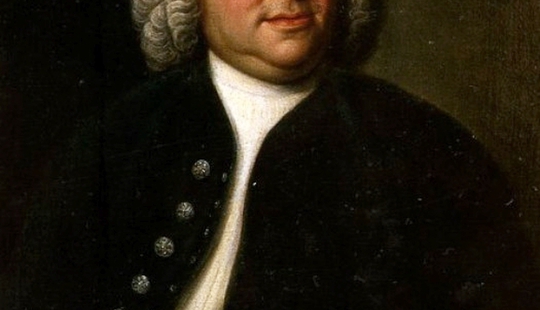
Boards of Canada had a point when they declared that Music is Math. I suspect that the likes of Autechre and Battles were more what they had in mind, but they could just as easily have been referring to Johann Sebastian Bach. I’m the sort of person who tends more towards art and history, but I know there are plenty of people out there with a very different mindset. These people are systematic, love patterns and interconnected sets of complicated rules. They tend to be good at learning languages, solving equations and playing instruments. Bach’s music was made for minds like these, and he provided an almost limitless supply of it. Calling him “prolific” is a bit like describing the universe as “fairly large” - his lifetime of diligence resulted in more than a thousand works. His music is sometimes written off as arcane, dry, impenetrable and exhausting, and while it’s true that he can be quite hard work sometimes, don’t be put off, because like any music, the more effort you put in, the greater the rewards are. With careful listening and a little patience, Bach’s intense seriousness and mathematical rigour begins to unfold into a world of surprising beauty, grandeur and depth. He took musical forms which were once just technical exercises and transformed them into utterly immersive worlds of sound. The endless flow of detail in his work could keep even the most fanatical listener occupied for several decades. I won’t say any more here about the particular qualities of Bach’s music, because they will become obvious once you start listening, and because there’s so much of it to get through. What we do need, however, is a little, ahem, Bachground information.
The term “classical music” covers an awful lot of material, but strictly speaking, the Classical Period actually refers to the time after Bach’s death – the era of Haydn, Mozart, and early Beethoven. Bach himself arrived at the end of another period altogether – the Baroque, a word which, for modern listeners, is more closely associated with a cluster of bands from the Sixties - The Beach Boys, The Zombies, The Left Banke, and so on. In that context, “Baroque” was a convenient journalistic term for what was essentially pop music with harpsichords and violins bolted onto it, but the word’s original use was equally arbitrary. Initially, it was misshapen pearls collected by Renaissance aristocrats which were described as “barroca”, but the word was soon taken up to describe new and unusual styles of visual art, before eventually being applied to music. So, like a lot of genre names today, “Baroque” isn’t a particularly accurate or even useful way of describing the music to which it refers, but the name has stuck nonetheless.
There are many qualities which make Baroque music distinct and recognisable, the most obvious of which is the instrumentation. The piano was invented in Bach’s lifetime, but it would be decades before it acquired the sound we know today. Other keyboard instruments, particularly the harpsichord and the organ, were used instead. String instruments were quieter and used catgut strings instead of later, synthetic materials. Orchestras were also much smaller, often using less than twenty people. The construction of the music itself was also different, with greater emphasis on balance, repetition and ornament, as opposed to the development and transformation favoured in later eras. Bass lines were also much more important – often what can seem like a very complex piece has, at its heart, a very simple ground bass. Composers of the time were regarded as servants or skilled craftsmen rather than as artists - they existed to serve their patrons, as well as God, so personal expression (in the sense we understand it today) was neither desirable nor necessary.
Bach was not hugely well-known while he was alive, and we know relatively little about his character. We do know that he was a deeply religious man who was committed to his family, that he moved successfully through a number of prominent musical positions in various German cities, and that he once got into a fight with a bassoonist, but to be honest, that’s about it. For decades after his death he was remembered primarily as a skilled organist and teacher, rather than as a composer, and his works came to be seen as old-fashioned. Meanwhile, the two other composers born in the exact same year as Bach, Handel and Scarlatti, were celebrated for their forward-looking compositions, while his sons J.C, C.P.E, W.F and J.C.F Bach had become more famous for their own music. Gradually, however, composers and connoisseurs began to investigate Bach again, and his extensive use of counterpoint became a huge influence for a whole new generation of composers. Early enthusiasts included a couple of obscure musicians named Mozart and Beethoven, who both recognised and imitated Bach’s genius. But it was another few decades before Bach’s return to popularity really began in earnest, thanks to another composer - Felix Mendelssohn, who restaged some of the composer’s choral works. For Bach, music was an all-consuming passion, defining every aspect of his life, which must have been a constant frenzy of teaching, composing and playing. His works are so rich that concentrating on them allows you to shut out the rest of the world entirely, and focus solely on the internal logic of music.
Bach in Black
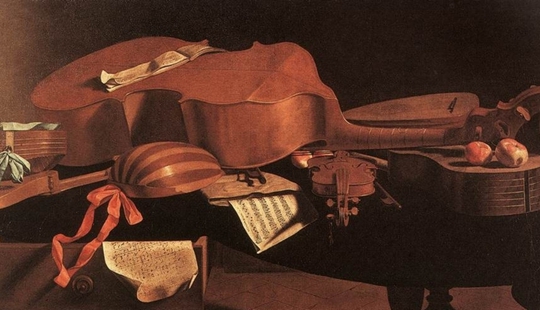
The Brandenburg Concertos are some of Bach’s most famous and accessible pieces, and are probably the best place to start your Bach pilgrimage. The aristocratic patron for whom the pieces were written never actually listened to them himself, but his Protestant taste for relatively simple music with an emphasis on melody ensured their huge popularity today. Hopefully if you’ve read this column before then you’ll know roughly what a concerto is, but the Brandenburgs put a slight twist on the genre by giving solos to several different instruments in each piece. All six are brilliant, and because this is the Baroque, they’re also wonderfully concise. These videos also give a general feeling for the music of the period, its structure, and the more historically accurate way it’s performed today. In the first video, watch out for the insane harpsichord solo which starts six minutes in, and in the second, listen out for the frantic viola duel:
Bach’s other concertos are also fantastic, but they’re also slightly confusing. Many of the original scores have been lost, with parts reconstructed from transcriptions for other instruments. As a result, you can end up hearing what is basically the same piece being played on a violin, a harpsichord, or an oboe. What this means is that we have the choice, as listeners, to select whichever arrangement of a concerto we prefer. Here are a few of the best bits, with the instrumentation that I think works best:
If you prefer something a little calmer, have a listen to the slow movements from the double concertos included on the playlist which you can find at the start of the article.
Suite Dreams
If you enjoyed the concertos, it’s also well worth investigating Bach’s orchestral suites. Below is an extract that you probably recognise already, and I’ve also included the chirpy “Badinerie” from the second suite in the playlist at the start of the article.
Where are Bach’s symphonies? Well, he didn’t write any, because the genre was still in its infancy, and didn't really gain widespread popularity until much later. What Bach did write, though, was a huge amount of solo instrumental music. These works are often grouped under a lot of different titles like partitas and sonatas, but they all more or less follow a single format – the suite. In Bach’s suites, there are usually six sections, each of which uses a different kind of dance as a basic musical template. There were many different kinds of dance which came from all over Europe, but the only thing you really need to keep in mind is that each uses a different rhythm, from slow sarabandes to lively gigues. The six solo cello suites are amongst the most famous and popular of all his works, and are a great place to start exploring his more intimate instrumental pieces. Like many of the other suites, they gradually become more complex as you move through them, becoming more ornamented and technically demanding. I’ve picked out a couple of my favourite movements, but if you enjoy them, you absolutely must listen to the suites in full. Seriously. Don’t just listen to the bit that was in Master & Commander and then stop. Keep going – you owe it to yourself to hear them properly. Taking the “greatest hits” approach to classical music is fine as an introduction, but as with anything, to gain a real appreciation requires commitment and dedication. And now, after that little rant, I leave you with the amazing Mischa Maisky:
The cello suites have become popular because they were rediscovered relatively recently, but Bach’s other instrumental suites are just as accomplished. The sonatas and partitas for solo violin are especially good, particularly the famous Chaconne, which showcases a huge range of techniques and moods available to a violinist, and which some musicologists believe may have been written as an expression of Bach’s grief after the death of his first wife. There are also suites for lute, flute, and harpsichord, extracts from which can be found on the playlist at the start of the article. They should give you a flavour of the suites – you can explore the rest for yourself.
My Bach Pages
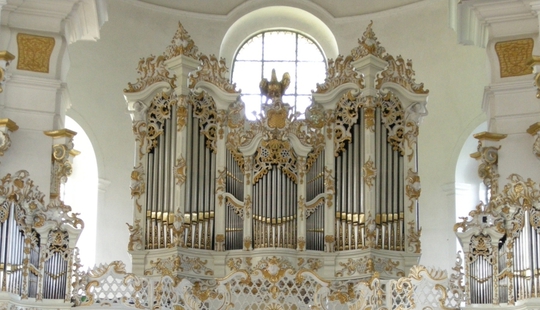
“If he continues to play in this way, the organ will be ruined in two years, or most of the congregation will be deaf.” – a local councillor on Bach
Next we come to the Bach works I like best, and where his style seems most fitting – his organ music. Bach was one of Europe’s leading experts on the organ, so when he wasn’t playing them, he was advising people about how to repair them. The organ is unbelievably difficult to play, as it requires not only both hands playing several layers of keys, but both feet as well, operating the deep bass sounds of the pedals below. Bach even wrote a little pedal exercise to get his feet warmed up.
A musical form which Bach used very frequently in his organ works was something called a fugue. There is no easy way to explain in words what a fugue is, but I’m going to try anyway. Fugues always begin with a short opening tune, called the Subject, which forms the basic structure of the piece. Then, depending on how complex the fugue is, a number of different parts, called Voices, repeat the Subject at different pitches or provide layers of ornamentation on top of it. To prevent this dense mesh of sound becoming a mess, fugues have a very strict, regular beat, and the relationships between the Voices are governed by an insanely complicated system called Counterpoint. Fugues are so bewildering that some people have even written their own incredibly nerdy music to try and explain them.
LISTENING in TO other A words FUGUE it IS can LIKE be TRYING completely TO baffling READ if TWO you SENTENCES don’t AT concentrate THE and SAME pay TIME attention. With practice however, you can learn to spot a fugue, because the basic texture is readily recognisable. Fugues are often preceded by Toccatas, which are sections designed to be difficult to get your fingers round – it comes from the Italian toccare, “to touch”. While all this might sound a bit obscure, it’s probably more familiar than you realise:
The irony is, however, that despite being Bach’s most famous piece, it’s likely that he didn’t actually write it. But it’s still a great bit of music, so who really cares? If you watched the video carefully you may also have noticed that the organist and his assistant kept changing the tone by adjusting the little wooden handles on either side. These are the organ stops, hence the expression “pulling out all the stops”. The stops control which of the several thousand organ pipes are used at any given time. This allows the organist to produce a wide range of sounds, pitches and timbres, and even imitate other instruments, including the human voice. The organ was a Minimoog, a Roland TR-808 and a vocoder all rolled into one. And if you think that comparison seems a bit forced, you’re wrong.
Here are a couple of Bach’s other best-known organ works, starting with the Passacaglia and Fugue in C Minor in which Bach takes a seemingly simple bass line and gradually builds more and more ornamentation onto it. This piece, like several other works by the Bach, has also been arranged for orchestra by a later composer, so if you find the organ a little monotonous, you can always listen to this version instead. The “Little” Fugue in G Minor (also below) is one of the best pieces to listen to in order to understand what a fugue actually is – listen carefully to the opening subject, and then watch out for the moments when it appears again at a different pitch. This selection is only a tiny fragment of Bach’s output for the organ, and there are many more pieces to be found in the playlist at the start of the article.
Baroque Lobster

“In Bach the vital cells of music are united as the world is in God.” – Gustav Mahler
Bach’s choral music is, for me, his most entertaining work. The composer was obliged to produce vast quantities of religious music because he served as music director for several churches in the city of Leipzig. He evidently relished the task, because it gave him an opportunity to serve God through sound. Bach’s Mass in B Minor is quite simply one of the single greatest choral works ever composed, and as ever, I recommend listening to the whole thing, but here are a few of highlights, which accompany some of the most joyful parts of the Latin text. But you don't have to be an Oxbridge classics scholar to understand this mass - it's just great music, pure and simple.
Next up is the St. Matthew Passion, an Oratorio which sets the story of Christ’s final days to music, and is arguably Bach’s greatest work. What’s an oratorio? Well, if you take an opera, get rid of the sets and the acting, change the subject from mythology to religion, put the musicians and the singers on stage together, and then replace dialogue with narration, you’ve got yourself an oratorio. The advantage of the oratorio is that it allows you to put in all kinds of choral effects that would seem contrived in the already ridiculous plot of an opera. In the St. Matthew Passion, a tenor plays the part of St. Matthew the Evangelist, filling in all the plot details from the Bible with recitatives. These sections are interspersed with chorales (short hymn-like tunes) sung by the whole choir, and arias - longer songs performed by four soloists (Soprano, Alto, Tenor and Bass) which are usually reflections on what has just happened in the story. For example, after Peter betrays Christ, there is a poignant aria which is concerned with forgiveness and mercy. If you listen to the full piece along with the lyrics, you can hear where Bach has used a wide range of musical effects to heighten the drama. For instance, whenever Jesus speaks, he has his own specific instrumental accompaniment, forming a musical “halo” which no other character is given. Bach also took advantage of the various crowd scenes in the story as a platform for intricate choral writing – when Christ is mocked, the choir let you hear their scornful voices; when the mob urges Pilate to crucify him, the choir bays for blood, and so on. Bach also used word-painting (making the music literally match the words) to brilliant effect. For example, after Christ dies, the low strings produce the earthquake mentioned in the text. This is a long piece, and brilliant from start to finish, but here are a couple of particularly notable extracts:
Slightly less well-known but equally rewarding choral pieces include the Christmas Oratorio, The St. John Passion and the Magnificat. This electrifying version of the opening chorus of the Christmas Oratorio is performed by the Monteverdi Choir and the English Baroque Soloists, who are some of the finest interpreters of Bach working today. They’re led by the brilliant John Eliot Gardiner, who has produced many definitive recordings of Bach’s works. I don’t often highlight particular performances because people very quickly become snobbish about these things, but this version is truly great.
Aside from these lengthy Oratorios, Bach also wrote over two hundred shorter choral pieces called cantatas. Their quality is consistently high, and as a body of work they are massively underrated. A few movements, such as “Jesu, joy of man’s desiring” and “Sheep May Safely Graze” have become particularly famous. I haven’t included these pieces here, but, as ever, they can be found on the playlist at the start of the article.
Paperbach Writer
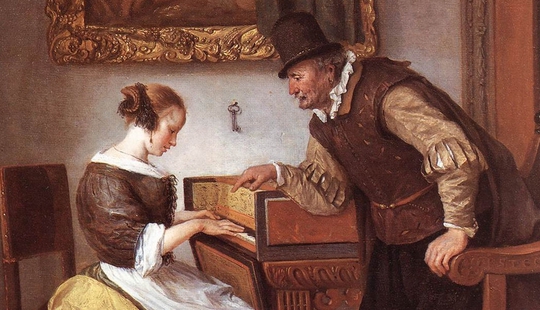
“Once I understood Bach's music, I wanted to be a concert pianist. Bach made me dedicate my life to music.” – Nina Simone
Bach also wrote a huge amount of material for the keyboard. I say “keyboard” because there’s some flexibility in how you play these pieces. For most of Bach’s life, he played on the harpsichord, but at the end of his life the fortepiano was just beginning to gain acceptance, and by the time his work was popularised again, the modern piano was in widespread use. In the 20th century, a number of landmark recordings by Bach fanatics like Glenn Gould made the piano seem like the natural instrument to use, but in recent decades the advent of Historically Informed Performance has seen Bach come full circle, with a return to the harpsichord. I think it’s silly to be too much of a purist about these things, so again, it’s really up to the listener to decide which versions they prefer and why. Personally, I like a bit of everything. The harpsichord produces a very specific kind of crunchy musical texture which you can hear Bach exploiting in some of his works, but on the other hand, it can become irritating because it has no dynamic range – every note is exactly the same volume. Some works benefit from it, while others sound better with the clarity of the piano – it simply comes down to personal preference.
The Goldberg Variations are some of Bach’s most important keyboard works, and are named after the musician they were composed for. The Theme and Variation format was nothing new in Bach’s time, but this set showed how it could become a vehicle for truly sublime music. The Goldberg Variations demonstrate once again Bach’s ability to superimpose worlds of detail onto an apparently simple structure. Here are the first eight variations as an introduction:
Another of Bach’s major contributions to keyboard music were the two books of The Well-Tempered Clavier. The term “well-tempered” refers to a set of ideas in music theory to do with tuning and pitch, and to be perfectly honest I have no idea what it really means. The important thing, however, is that Bach constructed this set of pieces to show that it was possible to write and play music in every single musical key, regardless of the limitations of the instruments he used. The Well-Tempered Clavier became extremely influential (particularly on Beethoven, who referred to Bach as “The Immortal God of Harmony”) because it showed that you didn’t just have to stick with an obvious tone – instead you could modulate between all kinds of remote and obscure keys. Each book of the Well-Tempered Clavier is divided into 24 pairs of preludes and fugues. I don’t recommend trying to tackle the whole set at once, because it’s more than four hours long altogether, but this is a link to the opening prelude and this is a link to one of the fugues, played on piano and harpsichord respectively.
Fortunately, Bach also wrote a few keyboard works that are slightly easier to digest – the brilliant but confusingly-named Italian Concerto, and the Chromatic Fantasy & Fugue, which made unusually extensive use of the black keys, hence its name.
Bacchanalia
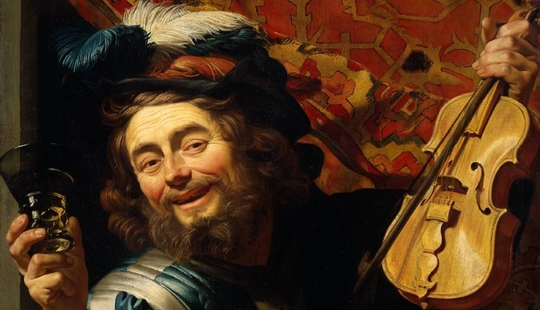
On a final note, I just want to mention a couple of important pieces which don’t really fit neatly into any other musical category. By the end of Bach’s life, his eldest son Carl Philipp Emmanuel had become famous in his own right, and was employed as court composer to King Frederick the Great of Prussia. Frederick wrote and played his own flute music, and was keen for Bach Senior to visit his court and play the newfangled fortepiano which had been built for him. Bach did come to Prussia, and was invited to improvise at the keyboard with a theme composed by the King, a task which he duly completed. He was then challenged to write a fugue based on this tune which had six different voices in it, rather than the usual three or four. This proved too difficult to accomplish on the day, but Bach went home, considered the problem carefully, and eventually came up with a solution. The resulting piece, the Ricercare a 6, proved to be one of his finest keyboard pieces. It is also one of the most difficult to listen to, but thankfully the twentieth-century Austrian composer Anton Webern wrote an orchestral version which allows all the interlocking parts to be heard clearly, and it’s this version which I’ve included below. If you’re a purist, then you can also find the original on the playlist at the start of the article. The Ricercare was grouped together with a several other pieces all based on the King’s theme, forming a collection known as The Musical Offering. This collection also includes one of Bach’s best pieces of chamber music, a Trio Sonata written for keyboard, flute and violin.
Similarly confusing is the work which was so convoluted and elaborate that Bach himself did not live to complete it. This is The Art of Fugue, a puzzling and enigmatic piece which might not have been intended for playing at all. Whatever its purpose, The Art of Fugue shows, more than any other piece, Bach’s total mastery of counterpoint and his ability to create incredibly intricate forms from the simplest of ideas. The last part of the work uses a musical code – the notes of its opening tune spell out the name BACH, but oddly enough it was this very section which remained unfinished at the composer’s death, meaning that the piece breaks off abruptly - a strange and haunting conclusion to a lifetime of musical endeavour. Bach also gave no indication as to the instrumentation of this piece, although it is most frequently performed on keyboard instruments today. Personally, however, I think The Art of Fugue is easiest to listen to when a string quartet plays it. Here are the Emerson Quartet doing just that:
Bach’s output is as broad as it is deep – there are always new and unfamiliar pieces to discover, and even when you become accustomed to an individual work, there are always new layers to unpick. His music is an inexhaustibly fascinating world unto itself. Oh, and finally, did I forget to mention P.D.Q. Bach?
Read the other columns in The Classical series here.




















